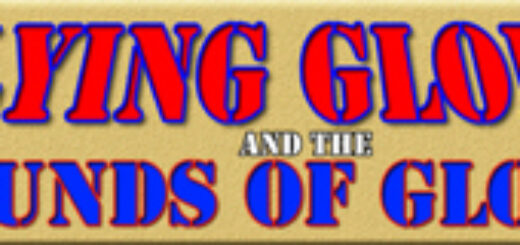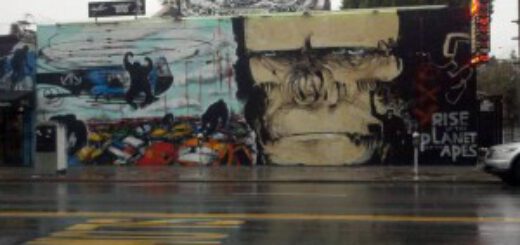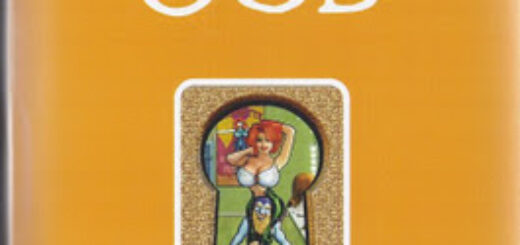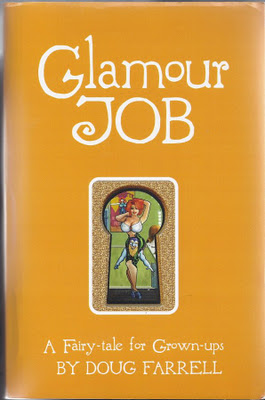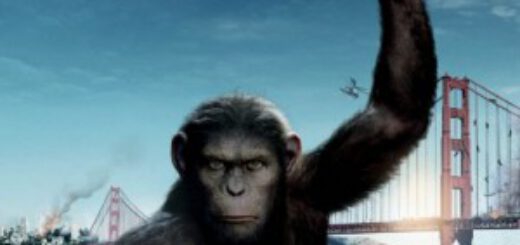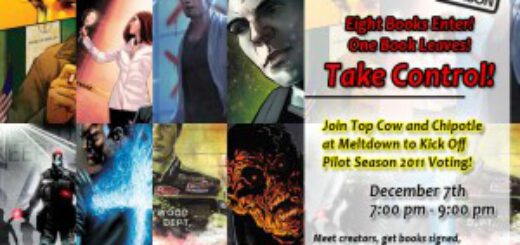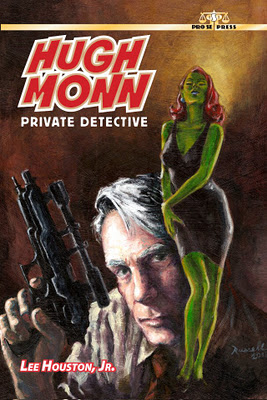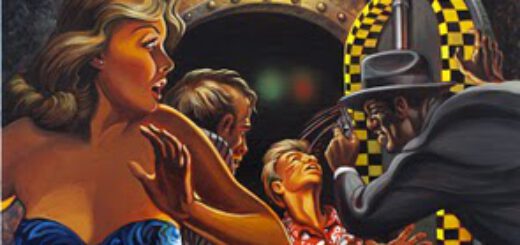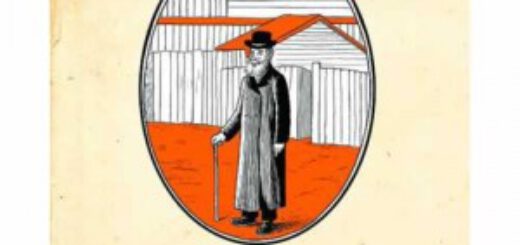Tagged: Los Angeles
Rise of the Apes Street Mural
 Over the weekend, we told you that Australian born street artist Anthony Lister had arrived in Los Angeles, working throughout the nights to create a gigantic street mural that was inspired by Rise of the Planet of the Apes. Today marks the film’s debut on Blu-ray and DVD, coming from Twentieth Century Home Entertainment.
Over the weekend, we told you that Australian born street artist Anthony Lister had arrived in Los Angeles, working throughout the nights to create a gigantic street mural that was inspired by Rise of the Planet of the Apes. Today marks the film’s debut on Blu-ray and DVD, coming from Twentieth Century Home Entertainment.
Here’s a look at the production using time lapse photography:
Related articles
- Ready for an Ape-FIlled Christmas? (comicmix.com)
FORTIER TAKES ON FAIRIES AND GOBLINS!
ALL PULP REVIEWS BY RON FORTIER
GLAMOUR JOB
By Doug Farrell
BookSurge Publishing
484 pages
ISBN – 10: 141967496X
ISBN – 13: 9781419674969
Release date – Sept 21, 2007
(fantasy – adventure – pulp)
No Contact Data
About the Author –
Doug Farrell has been a professional actor most of his adult life and spent several years performing comedy a Los Angeles improve troupe. He’s married to his best friend Ellen and raising three remarkable children with her. He taught college classes, was a vegetarian chef and installed home theaters. Recently at night he’s been a guide for ghost tours, telling Savannahs’ paranormal stories to people from around the world. This is his first novel.
Every now and then, I trip over a book that’s really hard to describe genre-wise and this is such a case. It’s a madcap adventure that falls somewhere between fantasy, slapstick comedy and social satire. That all these elements mix effectively and in the end produce a heady concoction of genuine adult delight is a testament to Farrell’s own imagination in brewing what he aptly describes as “A Fairy-tale for Grown-ups.”
The set up deals with a fairy war that occurred in another dimension wherein the goblin race lost and was forced to flee to our world, arriving in 1947, two years after the end of World War II. Convincing certain human scientist to help them, the goblins invented special disguises that allowed them to go undetected in our world and for decades walked among humans, some even interbreeding with them. Ultimately the same scientists who developed these sophisticated camouflages saw the potential for monetary wealth by using the same formulas to create beauty aids for human women. They create Glamorine, a Chicago based million dollar cosmetic empire built on the results of these techniques and certain globin magics.
The book’s theme plays with duel definitions of the word glamour. The first being a quality of fascinating, alluring, or attracting, especially by a combination of charm and good looks. It also means magic or enchantment; spell; witchery.
The protagonist is super model and the face of Glamorine, Laurie Morgan, whose grandfather was one of the scientist who created the company. As the story opens Laurie has become disillusioned by her near perfect life and is in the process of divorcing her loving husband, Nick. Laurie is suffering from ennui unable to explain her own dissatisfaction and believes she’s become trapped in a dull, boring routine of existence. No sooner is the divorce granted then she is contacted by a blue gnome name Hawley disguised as a little girl. He warns Laurie that her life is in danger. As if confronting an actual blue dwarf weren’t enough, Laurie begins to running into women throughout Chicago who looked exactly like her.
As paranoia begins to set in, Hawley explains that there is a goblin revolution in the works. After decades of living in secrecy amongst mankind, a group of goblin leaders have concocted a scheme to take control of Glamorine and replace its board of directors, including Laurie and her grandfather, with phony disguised goblins. Once they’ve achieved this end, they plan on poisoning the cosmetics produced to Glamorine to eliminate all of mankind and take over the Earth.
Needless to say having an army of vicious goblins out to do her in is more than enough motivation to snap Laurie out of her malaise and back into living at full tilt if only to stay alive. Before the book’s conclusion arrives, she will have been held prisoner in an underwater complex below Lake Michigan, met and been devoured by a fire breathing dragon and allied herself with tiny pig-fairies only she can see. “Glamour Job” is a rollicking tale that never lets up and is filled with satirical jabs at how we treasure a make-believe beauty that is simply an illusion devised by Fifth Avenue to milk millions from starry eyed little girls all wanting to grow up and become runway princesses. But do be warned, this is only the first chapter in a trilogy and the ending does come somewhat abruptly.
We also note by the print date that “Glamour Job” is four years old. All the more reason to seek it out as it might have flown under your radar. Urban fantasy isn’t one of this reviewer’s most favorite genres, but “Glamour Job” has enough action muscle to sustain it for even the most jaded pulp reader. If you are looking for something truly different and fun, you would be hard press to do much better than this book.
Ready for an Ape-FIlled Christmas?
 Twentieth Century Fox Home Entertainment releases the surprisingly satisfying Rise of the Planet of the Apes on Blu–ray and DVD Tuesday.
Twentieth Century Fox Home Entertainment releases the surprisingly satisfying Rise of the Planet of the Apes on Blu–ray and DVD Tuesday.
Check out this newly created interactive trailer.
Meantime, yesterday, Australian street artist and painter Anthony Lister began working on creating a fabulous piece of street art inspired by the Rise of the Planet of the Apes. Lister arrived in Southern California straight from Art Basel Miami Beach, the most prestigious art show in the Americas, where he painted several murals across the city. The mural is being painted at 7769 Melrose Ave in Los Angeles across the street from Fairfax High School, and Lister will be there until Monday afternoon.
We hope to share a timelapse video of the work from start to finish some time next week, after Lister’s work is complete.
Pilot Season 2011 Voting Kicks Off With Meltdown and Chipotle
 New York, NY (December 2, 2011) Top Cow Productions and Image Comics announced today a premiere launch event at Meltdown in Los Angeles for the Pilot Season 2011 voting period. The Pilot Season “Take Control” party invites Los Angeles fans to meet the various creative teams involved in 2011’s Pilot Season competition, get their books signed, and get the details on how they can determine the winning series this year. The event is co-sponsored by Chipotle Mexican Grill, through arrangement with marketing firm Bonfire Agency.
New York, NY (December 2, 2011) Top Cow Productions and Image Comics announced today a premiere launch event at Meltdown in Los Angeles for the Pilot Season 2011 voting period. The Pilot Season “Take Control” party invites Los Angeles fans to meet the various creative teams involved in 2011’s Pilot Season competition, get their books signed, and get the details on how they can determine the winning series this year. The event is co-sponsored by Chipotle Mexican Grill, through arrangement with marketing firm Bonfire Agency.
Since 2007, Pilot Season has become the leading fan-driven comic event, allowing creators to compete with brand-new original properties for fan votes. This year, Top Cow released eight unique pilot issues by eight creative teams ranging from established industry pros to up-and-coming talent to screenwriters and even one NFL All Star. With all eight books in stores, voting will begin on Monday, December 5th at topcow.com, where fans can also find additional information on each title.
To kick off the highly contested month of voting, Top Cow and Image Comics have partnered with Meltdown Comics to host a “Take Control” launch party on Wednesday, December 7th from 7:00-9:00pm. Fans will have the opportunity to mingle with the creative teams, get their Pilot Season issues signed, receive free comics from Top Cow, and enjoy free food and drinks furnished by Chipotle Mexican Grill. Confirmed guests include Joshua Hale Fialkov, Rahsan Ekedal, Morgan Davis Foehl, Dennis Calero, Brad Keene, Matt Hawkins, Filip Sablik, Nick Nantell,Dan Casey, and Troy Peteri. All fans in attendance will also receive “Buy One, Get One Free” certificates for future visits to Meltdown’s neighborhood Chipotle at 7660 Sunset Blvd. Meltdown Comics, one of Los Angeles’ premiere comic shops, is located at 7522 Sunset Blvd, Los Angeles, CA 90046 and can be reached at (323) 851-7223.
This year’s voting process has evolved from previous years. From December 5th to December 18th, fans will be able to vote as often as they would like for their favorite series. On December 19th, the four highest vote-getters will continue to the second round. Until December 25th, fans will be able to vote once per day for their favorite series, with the highest two vote-getters continuing to the final round of competition on December 26th. The final winning series will be determined when voting closes on December 31st and will be announced in early January 2012.
“Pilot Season is one of the highlights of the year for all of us at Top Cow and we’re thrilled to kick off the voting in style at Meltdown,” commented Top Cow Publisher, Filip Sablik, “Rather than just do a standard signing event, we thought it’d be fun to have a party and celebrate all these great new books! I wouldn’t be surprised if we had a couple impromptu campaign speeches on December 7th.”
“We’re thrilled to have Chipotle on board for this leg of the Pilot Season program,” added Steve Rotterdam, Bonfire Co-Founder and Partner. “It makes the event all the more celebratory.”
For more information on Pilot Season, go to topcow.com. For additional information on the event and Meltdown, head to meltcomics.com.
Derrick Ferguson Hires HUGH MONN, PRIVATE DETECTIVE
SURF PULP-As Told to Chuck Miller!
Will The Rest Of DC Comics Move?
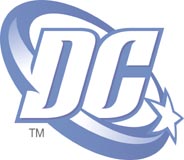 DC Comics has already had a large job exodus from New York to Los Angeles, and now there are signs that what’s left may have to pack up soon, as well as the rest of Time Warner. Deadline Hollywood has the story:
DC Comics has already had a large job exodus from New York to Los Angeles, and now there are signs that what’s left may have to pack up soon, as well as the rest of Time Warner. Deadline Hollywood has the story:
CEO Jeff Bewkes told staffers in an email that the company’s preparing to evaluate “our office footprint in the New York metropolitan area and develop a long-range plan to meet our future needs.” The team leading that process — to be run by Chief Financial and Administrative Officer John Martin and Global Real Estate SVP Tom Santiago — probably won’t make a decision until the end of 2012. Then it could take years to implement. The corporate ranks and cable channels including CNN probably will stay in the Time Warner Center at Columbus Circle; the company owns about 1 million square feet in the building. But Time Warner leases an additional 3 million or so additional square feet of office space in the New York area. The agreement for the publishing unit’s operations at the Time & Life building expires at the end of 2017, while the one for HBO’s home on 6th Ave runs out in 2018. There are plenty of options in Manhattan, including the new World Trade Center. But neighboring New Jersey and Connecticut probably will try to persuade Time Warner to move some of its operations, and jobs.
via Time Warner Launches Review Of NYC Office Options.
Related articles
- Dan DiDio’s Spinning Plates At DC Comics (bleedingcool.com)
MOONSTONE AND AUDIOCOMICS-TAKING NEW PULP FURTHER!!
Moonstone EIC Joe Gentile: “Moonstone is super excited to hear our stories done in this dramatic fashion! AudioComics brings a very professional quality sound, as well as great voice actors to the table, and the final result is the best we have heard! It’s not a plain ol’ audio book, it’s an audio play, like a private performance in your living room!” AudioComics co-founder Lance Roger Axt echoes Joe’s sentiments: “Audio theatre is simply one of the most exciting and accessible forms of entertainment available. This is not lost on Joe and the good folks at Moonstone Entertainment, and we’re very excited to be working with them and their roster of properties. Actually, ‘very excited’ may be an understatement! I mean have you seen their roster of properties lately?”
Yiddishkeit: Jewish Vernacular & The New Land
[[[Yiddishkeit: Jewish Vernacular & The New Land]]]
edited by Harvey Pekar & Paul Buhle with Hershl Hartman
Abrams Comicarts, 240 pages
 It always seemed to me like mine was the last secular “Jewish generation” in America. Born in the mid-1950s, in the depths of Brooklyn in a neighborhood adjacent to the heavily Orthodox neighborhood of Crown Heights, surrounded on all sides by three generations of family, including grandparents and great-grandparents born in the old country, the entire world seemed Jewish. Even when my family moved (briefly) to West Virginia (population 5,000, only seven of which were Jews), then back to Brooklyn, to Canarsie and East Flatbush, the feeling of Jewishness never went away. The neighborhoods were now a mix of Irish, Italian, and Jewish, even a sprinkling of Afro-Americans, but when the family gathered, Yiddish was still spoken among the adults when the topic wasn’t fit for kinder, children. As a result, der kinder learned to understand, if not speak, just enough of the mamaloshen (the mother tongue) to get the gist of what we weren’t supposed to hear.
It always seemed to me like mine was the last secular “Jewish generation” in America. Born in the mid-1950s, in the depths of Brooklyn in a neighborhood adjacent to the heavily Orthodox neighborhood of Crown Heights, surrounded on all sides by three generations of family, including grandparents and great-grandparents born in the old country, the entire world seemed Jewish. Even when my family moved (briefly) to West Virginia (population 5,000, only seven of which were Jews), then back to Brooklyn, to Canarsie and East Flatbush, the feeling of Jewishness never went away. The neighborhoods were now a mix of Irish, Italian, and Jewish, even a sprinkling of Afro-Americans, but when the family gathered, Yiddish was still spoken among the adults when the topic wasn’t fit for kinder, children. As a result, der kinder learned to understand, if not speak, just enough of the mamaloshen (the mother tongue) to get the gist of what we weren’t supposed to hear.
Popular entertainment was Jewish, too. The producers and writers behind many of the sitcoms were Jews and even if the characters weren’t Jewish (with the exception of The Goldbergs), the comedic sensibilities sure were. Ditto for the variety shows, where in addition to everything else, many of the hosts were Jewish as well. Milton Berle, Bob Hope, Jerry Lewis (although not Dean Martin), Sid Caesar. Allan Sherman sold millions of comedy albums in the early-1960s with song parodies that were flavored by schmaltz (chicken fat). Today, when he’s remembered, he’s remembered for his (mostly) WASPy “Hello Mudder, Hello Faddah.” Song-writing in the mid-20th century was so Jewish that according to ASCAP’s list of the top twenty-five most popular Christmas songs, twelve were written by Jews.
Even the Italians were Jewish in Hollywood. In The Detective, a 1968 mystery starring Frank Sinatra, Jack Klugman co-stars as one of Frank’s police colleagues who has a brief exchange with his wife in the sing-song cadence of Yiddish about whether or not he wants her to make him a “nice glass tea.” My great-grandmother drank hot tea out of a glass (never a mug), sweetening it with a cube of sugar between her teeth as she sipped.
Jewishness, if not Judaism, was everywhere. Hollywood is still a Jewish town, but the entertainment it now produces is far less so. Even the language of the Jews, Yiddish, has become somewhat catholic in appeal; every schmuck on the street thinks he’s a big macher because he knows a bissel Yiddish. And as the Jews have long known, there’s really nothing like Yiddish to make a point. As Neal Gabler (author of the excellent An Empire of Their Own: How the Jews Invented Hollywood) says in his introduction to Yiddishkeit: Jewish Vernacular & The New Land, “Yiddish is the most onomatopoeic language ever created. Everything sounds exactly the way it should: macher for a self-appointed big shot, shlmiel for the fellow who spills the soup and shlmazel for the hapless one (as in “poor shmuck”), shnorrer for a freeloader, nudnick for a pest. The expressiveness is bound into the language, and so is a kind of ruthless honesty….Yiddish has dozens of words for imbecile, a tribute to Jewish lucklessness…. There is no decorousness in Yiddish, nor much romance. It is raw, egalitarian, vernacular.”
Yiddish is an “amalgamated language, borrowing freely from German and Polish and Hebrew with its own unique constructions and confabulations,” and the people who speak it are the Yiddishkeit, or the Yiddish culture…although as Gabler points out, what the word encompasses is “so large, expansive, and woolly a concept that culture may be too narrow to do it full justice. ‘Jewish sensibility’ comes closer,” but, in the end, “You can’t define Yiddishkeit neatly in words and pictures. You sort of have to feel it by wading into it.” (more…)

